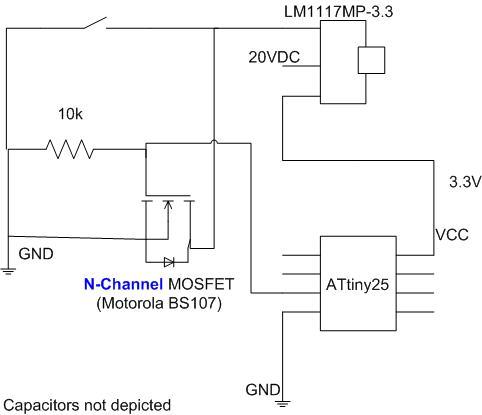Hi Paul,
thank you very much for your notes!!
“[…]One is that in the off state, there is still a possible current path from 20V through the regulator and the AVR to ground. […]”
–> That’s true and might be a real problem. Up to now I was using voltages below 10V (luckily considering my wrong assumption of 20V operating max of the volt. reg. …) and I noticed that almost the full voltage is seen by the AVR in the circuit. Obviously the resistance is high enough that it is not damaged in my circuit, but as you said, that might not work with a different circuit. When the circuit is in on state, the VCC is 3.3V as intended. Do you think the high voltage on the AVR can become a problem other than just switching it on?
“[…]Instead, it would be safer to make the ground pin on the AVR connect to the same node as the ground pin of the regulator, so that the FET can disconnect the entire circuit. […]”
–> That was my initial approach, but I recognized a voltage drop of about 1.8V over the mosfet (i.e. the ground pin of the regulator was 1.8V above the GND shown on the left of the figure. So if the AVR’s GND pin is connected to 1.8V, the lowest the AVR’s pins can deliver is 1.8V and thus the mosfet could not be turned off. Frankly, I haven’t fully understood the voltage drop of 1.8V…
“[…]I’m worried about is that the pushbutton is required to conduct all of the current used by the circuit before the FET switches on, which could easily be more than 100mA if you have a few things connected to the 3.3V line. You could possibly fix that by having the switch control the gate of the FET instead of the ground line, but you’ll have to be careful not to put a voltage above 3.3V on the AVR pin.[…]”
–>Thanks for the hint. You are definitely right, 100mA is not a whole lot. Would you say this is typically the limit for pushbuttons? Maybe I better control the gate by the button and just use a voltage divider to make sure the voltage on the pin is low enough.
Right now there are not a lot of components in the circuit. I will make the test circuit a little more representative, i.e. include some more realistic components, then test again. Yep, I do have an old oscilloscope…
Thanks for the hint with the pushbutton switch. Very interesting. I’ll keep that in mind.
Sorry, there is no real project to show. I am basically playing around with the AVR and trying to “explore” topics that I find interesting. But I was thinking about switching off a circuit when the supply voltage drops below a specific value.
Thanks again!
Best regards from Germany!
Talk soon,
Robert

